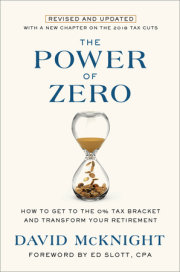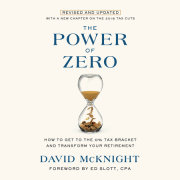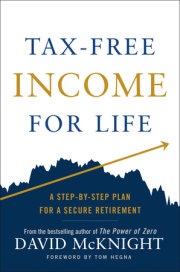ONE
A Gathering Storm
“Delight in smooth-sounding platitudes, refusal to face unpleasant facts, desire for popularity and electoral success irrespective of the vital interests of the State . . .”
—Winston Churchill, The Gathering Storm
On January 11, 2011, a CPA named David M. Walker appeared on national radio and made a grim prognostication: Based on the current fiscal path, future tax rates will have to double or our country could go bankrupt. He then challenged the national listening audience to come up with a four-letter word that would explain why. The calls came pouring in. “Debt?” came one answer. “Wars?” came another. “Kids?” came the next. After a few more wayward guesses, David Walker finally revealed the answer. “It’s math.”
Who is David Walker, and what does math have to do with the future of our country? For an 11-year period starting in 1998, David Walker served as the Comptroller General of the United States and as the head of the Government Accountability Office. In short, he was the CPA of the USA, and the nation’s chief auditor. Having performed in that capacity during both the Clinton and Bush administrations, he knows more about our country’s fiscal state than perhaps anyone else on the planet. Since his resignation in 2008, Walker has been crisscrossing the country, raising the warning cry, and discussing sensible solutions with anyone who will listen.
To understand the urgency behind David Walker’s mission, you need look no further than the mathematical realities facing Social Security. The Social Security Act was passed into law in 1935 as the lynchpin of Roosevelt’s “New Deal” with America. When it was first implemented, the math behind it (based on expected birth rates and life expectancies) ensured its financial viability into perpetuity. There were an astounding 42 workers putting money into Social Security for every one person who took money out. Ironically, the official retirement age at that time was 65, well beyond the then average life expectancy of only 62. The program’s administrators didn’t even anticipate that the average American would live long enough to ever draw on Social Security. If you did make it to 65, you drew on Social Security for only a few years until you died! You see, Social Security was never intended to be a retirement program. It was merely insurance against living too long.
But then, something happened that would change Social Security forever. Soldiers came home from World War II and started to do something at a rate at which they’d never done before. They started making babies! Great, you may be thinking. More babies equals more workers, which mean more contributions to the Social Security program. That would be true if these “Baby Boomers” had decided to have nearly as many children as their parents did, but they didn’t. They had 32 million fewer children. And this is where the math to which David Walker refers catches up with us.
Today, there are no longer 42 people contributing to Social Security for every one person who takes money out of the program. The ratio has fallen to 3 to 1.1 And in another 10 years, it’s going to be closer to 2 to 1. Compounding the problem, Americans can now draw Social Security as early as 62 and, due to advancements in science and medical technology, retirees are living longer than ever. The reality is, if you start drawing on Social Security at 62, you’ll keep drawing it, on average, until age 85. In fact, octogenarians are the fastest-growing segment of our population.
The problem is, Social Security went from being insurance against living too long to an expensive retirement program that Americans rely upon for nearly a quarter of their lives! As of 2017, the Social Security program costs the government over $945 billion per year, or about 23% of the federal budget.2 And the consequences for the United States couldn’t be more devastating.
“A promise made is a debt unpaid.”
—Robert A. Service
The math behind the Social Security problem is emblematic of a much broader crisis facing our nation. Over the years, our elected officials have increasingly made promises, like Social Security benefits, without any thought for how they were going to pay for them. David Walker calls these promises “unfunded obligations.” The greatest of these unfunded obligations is the universal healthcare system for seniors implemented as part of Lyndon Johnson’s “Great Society” domestic programs of the 1960s. Medicare suffers from the same demographic challenges as Social Security. As of 2017, it costs the government over $590 billion per year, and these costs continue to spiral out of control. According to Walker, the fiscal strain of these two programs alone could bankrupt the United States of America.
A closer look at the numbers explains why David Walker has become so alarmed. To quantify the actual cost of these unfunded liabilities, the government employs its own unique (and creative) accounting method. Instead of telling us the actual cost of a program, they express the cost as the present value of a future obligation. For example, the government tells us that the cost of Social Security and Medicare is $42 trillion. What this really means is that we would have to have $42 trillion sitting in an account today, earning Treasury rates, to be able to afford these programs. But the government doesn’t actually have $42 trillion today, and if you look beyond 75 years, the real cost is much greater. All told, some experts put the actual cost over time at much closer to $120 trillion.
Present Value: To better understand this concept, let’s look at the following example. Suppose you believe that your car will need to be replaced in 10 years. You estimate that in 10 years a new car will cost you $20,000. So you ask yourself what amount of money would have to be invested today at a reasonable rate of growth (say, 5%) to be able to have $20,000 10 years from now. A quick calculation shows that $12,892 growing at 5% over that time period will give you $20,000 in 10 years’ time. In other words, the present value of the future cost of your car is only $12,892!
Let’s look at the math behind our country’s fiscal problems from a different angle. The United States currently spends roughly 76 cents of every tax dollar it brings in on four items: Social Security, Medicare, Medicaid, and interest on the National Debt.3 Absent any action on the part of Congress, however, the percentage of the government’s revenue required to pay for these four big-ticket items could balloon to 92 cents of every tax dollar by the year 2020.4 As these four expenses grow and compound, they begin to crowd out all other government expenditures.
Here are just some of the programs the government would have to pay for with the remaining 8 cents: Child Nutrition Programs, Homeland Security, Food Safety and Inspection Service, U.S. Forest Service, Drug Enforcement Administration, Public Housing Program, Animal and Plant Health Inspection Service, Bureau of Indian Affairs, Army, National Endowment for the Arts, Air Force, Rural Development, Coast Guard, Supplemental Nutrition Assistance Program (aka food stamps), National Park Service, Department of Family Services, U.S. Geological Survey, Environmental Protection Agency, Centers for Disease Control and Prevention, Immigration and Customs Enforcement, Secret Service, Supportive Housing for the Elderly Program, Federal Railroad Administration, Navy, Bureau of Land Management, Peace Corps, State Department, National Science Foundation, Congress, Fish and Wildlife Service, White House, Smithsonian Institution, Small Business Administration, Federal Highway Administration, disaster relief, federal courts, federal student loans, federal pensions, income assistance, IRS, NASA, FEMA, FAA, FCC, SEC, FBI . . .
And the list goes on. Can you see why David Walker and a growing contingent of economists are so concerned?
But Surely Taxes Could Never Double!
The mathematical reality is that, absent any spending cuts, tax rates would have to double. Come on, let’s get serious, you must be saying to yourself. Could tax rates really double?
A study of the history of taxes in the United States lends a bit of perspective. Over the last 100 years, tax rates in our country have been nothing short of a roller-coaster ride. When the government first began dipping its toe in the waters of income taxation back in 1913, it seemed harmless enough. In fact, the very first federal income tax rate was only 1%. But soon the thrill of income taxation became so addicting that the government got hooked.
By the time 1943 rolled around, the highest marginal tax bracket in our country had skyrocketed to 94%. These exorbitant rates were levied on any portion of your income that exceeded $200,000.
But did anyone really make that type of money back then? Actually, there was one person with whom you may be familiar. He was an actor who later became a politician. His name was Ronald Reagan. If you look at Reagan’s filmography, you’ll find that he never made more than two full-length movies in a year. You see, he made about $100,000 per movie, and, for anything he made above and beyond $200,000, he only kept 6 cents on the dollar. Truth be told, he didn’t even get to keep that—it went off to the State of California for state tax. So, if you study the life of Reagan, you’ll find that he never worked more than six months out of the year. Mathematically, it just didn’t make sense.
By the ’70s, things had improved, but not by much. Americans were still paying an astounding 70% on anything they made above and beyond $200,000.
Fast-forward to today. The top marginal rate at which the wealthiest Americans pay taxes is a mere 37%. How does 37% stack up against some of the tax rates in the past? You could make the case that taxes haven’t been this low in nearly 80 years! This is interesting because I routinely ask rooms full of people across the country, “How bad are taxes today?” And you know what they tell me? “As bad as they’ve ever been!” Truth is, taxes today are just about as good as they’ve ever been! The real question is, how long can these low rates last?
According to the Congressional Budget Office, if Social Security, Medicare, and Medicaid go unchanged, the government could be forced to adopt a three-bracket system in which some of your income gets taxed at 25%, some at 63%, and some at an astounding 88%!5
For you skeptics out there, let me take you back in time. From 1960 to 1963, the lowest marginal tax rate was 20%, the middle bracket was 69%, and the highest marginal tax rate was an astounding 91%!6 Folks, this is a path we’ve been down before. What’s that old adage? Those who don’t study history are destined to repeat it?
A few years ago I was watching the Road Runner with my kids. In this particular episode, Wile E. Coyote was up to his usual tactics in trying to subdue the Road Runner. He was building a bomb—made by Acme, of course—inside a shed also made by Acme. The Coyote was so intent upon completing the bomb that he didn’t realize that the Road Runner had pushed his shed onto a train track. What’s worse, he didn’t realize until the very last moment that a huge freight train was bearing down on him.
Now, if you found yourself on a track with a huge train bearing down on you, what would you do? You’d jump off, right? Well, when the Coyote saw the huge freight train approaching, he didn’t jump out of the way. He simply pulled down the window shade, thinking that the act of doing so would make the problem go away. Did the problem go away? Of course not. There was a huge explosion and, let’s face it . . . does the Coyote ever die? No, but as the smoke cleared, we could see the Coyote limping away from the wreckage, very much the worse for wear.
What possible application could a Road Runner episode have to my financial life? you must surely be thinking. Well, as Americans who have grown accustomed to investing in tax-deferred accounts such as 401(k)s and IRAs, we find ourselves standing on the tracks with a very real train bearing down on us, and it’s coming in the form of higher taxes. Now, given this reality, we have a couple of options. We can pretend like the problem doesn’t exist and simply pull down the window shade. Or, we can implement some proven strategies that can help remove us from the train tracks.
The purpose of this book is to share with you the proven strategies that will help you get off the train tracks and insulate your money from the impact of higher taxes down the road. Which brings me to the title of this book: The Power of Zero. You see, the only real way to protect yourself from the impact of rising taxes is to adopt a strategy that puts you in the 0% tax bracket in retirement. Why is the 0% tax bracket so powerful? Because of that same four-letter word: math. If you’re in the 0% tax bracket and tax rates double, two times zero is still zero! By implementing these concepts before tax rates rise, you can effectively remove yourself from the train tracks and protect your hard-earned retirement savings from the gathering storm that’s looming on our country’s horizon.
TWO
The Taxable Bucket
Getting to the 0% tax bracket is not something that happens by accident. Enjoying a retirement free from taxation takes proactive and strategic planning, and it must begin today. The longer you wait to get off the train tracks, the less time you have to haul yourself to safety. And let’s face it, taxes are not likely to stay at historical lows forever.
Critical to your journey toward the 0% tax bracket is an understanding of the three basic types of investment accounts. For our purposes, we’re going to refer to these three accounts as buckets of money. The three buckets are taxable, tax-deferred, and tax-free. Contributing dollars to these accounts in a willy-nilly or haphazard way during your accumulation years can have enormous unintended consequences during your retirement years and can even prevent you from ever being in the 0% tax bracket. The goal during your working years should be to allocate the right amount of dollars to each bucket so that during retirement all your streams of income are tax-free. Defining the pros and cons of each bucket can help you understand the correct amounts to allocate to each one. This chapter will focus on the taxable bucket.
1 “Social Security Online—HISTORY,” Social Security Administration, http://www.ssa.gov/history/ratios.html.
2 Fiscal year 2017 budget of the U.S. Government, Office of Management and Budget.
3 “Policy Basics: Where Do Our Federal Tax Dollars Go?” Center on Budget and Policy Priorities, last modified October 4, 2017, www.cbpp.org/research/federal-budget/policy-basics-where-do-our-federal-tax-dollars‑go.
4 Jeanne Sahadi, “Running the government on 8¢,” CNNMoney, January 21, 2011, http://money.cnn.com/2011/01/21/news/economy/spending_taxes_debt/index.htm.
5 “Long Term Economic Effects of Some Alternative Budget Policies,” Congressional Budget Office, May 19, 2008, 8-9.
6 “Tax Foundation,” U.S. Federal Income Tax Rates, http://taxfoundation.org/article/us-federal-individual-income-tax-rates-history-1913-2013-nominal-and-inflation-adjusted-brackets.
Copyright © 2018 by David McKnight. All rights reserved. No part of this excerpt may be reproduced or reprinted without permission in writing from the publisher.





